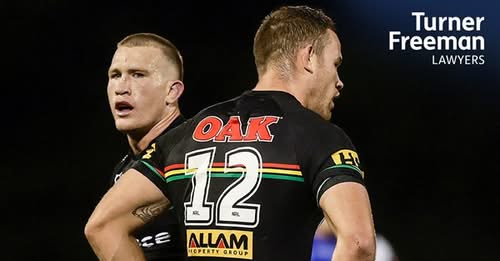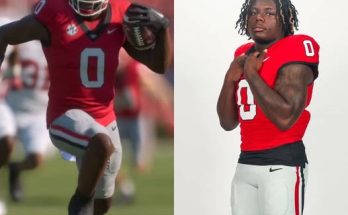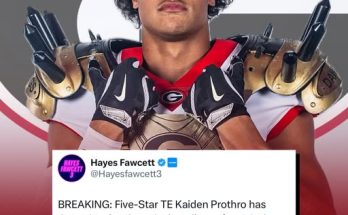Liam Henry, a promising and hard-hitting player known for his aggressive style on the field, now finds himself at the center of a storm following a controversial crusher tackle that has put his playing future under serious threat. The incident, which occurred during a recent high-stakes game, has drawn widespread attention from fans, commentators, and league officials alike. As the investigation unfolds, Liam faces a possible suspension that could impact not only his career but also the broader conversation about player safety and the rules governing tackling in the sport.
The crusher tackle itself was a moment that instantly polarized viewers. For some, it was a textbook example of physicality and competitive intensity that makes the game thrilling to watch. For others, it was a dangerous and reckless move that crossed the line, endangering an opponent’s health and forcing officials to intervene. The nature of the tackle—a forceful hit targeting the neck and head area—triggered immediate concern and calls for disciplinary action.
Liam Henry’s style of play has always been characterized by his physical presence and willingness to make bold plays. Over the course of his career, he has earned respect for his toughness and commitment, traits that often translate to game-changing moments on the field. However, the very qualities that have made him a standout player are now under scrutiny. The league has a responsibility to maintain the integrity of the sport and, equally important, to protect its players from unnecessary harm. This balance between competitive spirit and safety is delicate, and incidents like the crusher tackle put it to the test.
In the aftermath of the tackle, the league’s disciplinary committee quickly launched a formal review. Video footage, player testimonies, and referee reports are all being examined to determine the severity of the infraction and the appropriate response. The committee’s decision will not only affect Liam Henry’s availability for upcoming games but could also set a precedent for how similar incidents are handled in the future. The stakes are high, as the league continues to grapple with concerns over player safety, concussion protocols, and the long-term health risks associated with high-impact collisions.
Fans and analysts have been divided in their reactions. Many supporters of Liam Henry have come forward to defend him, pointing out that tackling is inherently a physical aspect of the game and that split-second decisions on the field can sometimes result in borderline plays. They argue that Henry’s track record does not suggest malicious intent, and that penalizing him too harshly might unfairly punish a player whose aggressive style is part of what makes him effective.
Conversely, others insist that the tackle went beyond the bounds of fair play and that the league must send a clear message that dangerous tackles will not be tolerated. The emphasis on player safety has increased dramatically in recent years, with stricter enforcement of rules designed to minimize head and neck injuries. This incident, some say, is a critical test of the league’s commitment to these policies.
Medical experts have weighed in as well, highlighting the risks associated with crusher tackles in particular. Such tackles, which often involve compressive force applied to the neck and upper spine, can lead to serious injuries including concussions, cervical spine damage, and in extreme cases, paralysis. The growing awareness of these dangers has led to a push for stricter regulations and better education for players and coaches. As a result, disciplinary bodies are under increased pressure to act decisively when incidents like this occur.
Liam Henry himself has responded to the controversy with a measured approach. In interviews following the game, he expressed regret if his tackle caused harm but maintained that his intention was never to injure an opponent. He emphasized his respect for the sport and his fellow players, acknowledging the importance of playing hard while also playing safe. His public statements suggest a willingness to cooperate fully with the league’s investigation and to learn from the situation.
The impact of a suspension on Liam Henry’s career could be significant. Missing key games would not only affect his contributions on the field but might also influence his standing with coaches, teammates, and fans. Moreover, a suspension could potentially affect his future contract negotiations and endorsements, as teams increasingly consider disciplinary history and reputation in their decisions. For a player at a pivotal stage in his career, this is an important moment of reflection and consequence.
At the same time, the situation highlights a broader issue within the sport. How do leagues balance the intense physical nature that makes the game exciting with the growing awareness of long-term health risks? The crackdown on illegal tackles and dangerous hits has intensified over the last decade, as more research reveals the severity of repeated head trauma. Rules have evolved, and so have officiating standards, with video reviews and stricter penalties becoming more common. Yet incidents like Liam Henry’s crusher tackle reveal that enforcement remains a challenging task.
The debate also raises questions about player education and coaching strategies. Some experts argue that players need more comprehensive training to recognize and avoid high-risk tackles, and that coaches should emphasize techniques that reduce injury risk without compromising competitiveness. This could involve changes to practice routines, drills focused on safe tackling methods, and clear guidelines on what constitutes illegal contact. The goal is to preserve the spirit of the game while ensuring that players return home healthy after every match.
In the court of public opinion, the outcome of Liam Henry’s case is being closely watched. Social media platforms are abuzz with opinions, some sympathetic to Henry’s position and others demanding accountability. This public pressure, combined with the league’s own commitment to player welfare, means that the disciplinary committee’s decision will be scrutinized intensely. Whether it results in a suspension or a lesser penalty, the message sent will reverberate through the sport.
The potential suspension also sparks conversation about consistency in disciplinary actions. Critics sometimes point to perceived inconsistencies in how similar infractions are punished, leading to calls for clearer standards and transparency in the decision-making process. For Liam Henry, this means that the outcome of his case could influence future rulings and shape the expectations for players league-wide.
Ultimately, Liam Henry’s situation serves as a reminder of the complex and evolving nature of contact sports. The physical demands are immense, and the line between aggressive play and dangerous behavior can be thin. Players, coaches, officials, and league administrators all share responsibility for navigating these challenges. As Liam waits for the final verdict, his case will likely contribute to ongoing discussions about how best to protect athletes while preserving the intensity and excitement that fans love.
For now, the focus remains on the investigation and the forthcoming decision by the disciplinary committee. Liam Henry’s future on the field hangs in the balance, and the consequences of this controversial crusher tackle will extend beyond one player, reflecting broader issues within the sport and its ongoing evolution toward safer, fairer play. Whatever the outcome, this incident underscores the importance of vigilance, responsibility, and respect in competitive sports.



